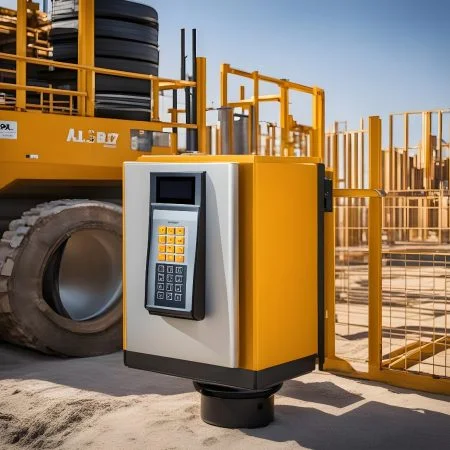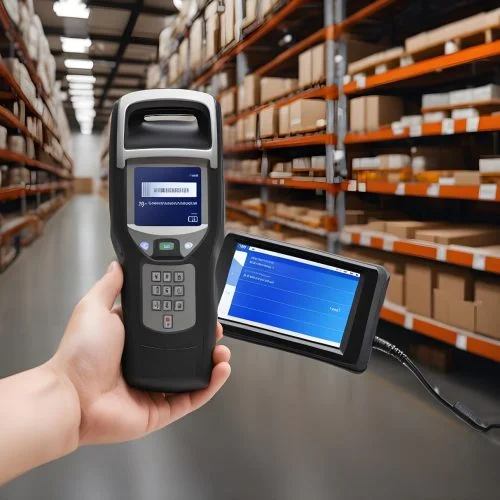Intelligent Construction with RFID Technology
RFID (Radio-Frequency Identification) technology has become increasingly important in the field of Intelligent Construction. It offers several advantages for managing construction projects efficiently and improving overall safety.

Here are some key Applications and Benefits of RFID in Intelligent Construction:
- Asset Tracking: RFID tags can be attached to construction equipment, tools, and materials. This allows construction managers to track the location and usage of these assets in real-time. It helps prevent theft, loss, and unauthorized use of valuable resources.
- Inventory Management: RFID simplifies inventory control by providing accurate data on the quantity and location of construction materials and supplies. This reduces waste, minimizes downtime, and ensures that the right materials are available when needed.
- Worker Safety: RFID tags can be integrated into workers’ helmets, vests, or badges to monitor their location on the construction site. In case of an emergency, this technology helps locate and evacuate workers quickly, enhancing safety.
- Access Control: RFID cards or badges can be used for access control to restrict areas within the construction site. Only authorized personnel with valid RFID credentials can enter secure zones, improving site security.
- Time and Attendance: RFID can automate the tracking of workers’ time and attendance, eliminating the need for manual sign-in sheets. This enhances accuracy in payroll management and project cost tracking.
- Equipment Maintenance: RFID tags can be used to schedule and track equipment maintenance. Automated maintenance reminders based on equipment usage help prevent breakdowns and extend the lifespan of expensive machinery.
- Quality Control: RFID tags can be attached to construction components, allowing inspectors to easily access information about specifications, quality standards, and installation instructions. This ensures that construction meets quality standards and regulatory requirements.
- Supply Chain Management: RFID technology can be extended to the supply chain, enabling real-time tracking of construction materials from suppliers to the construction site. This enhances logistics planning and reduces delays in material deliveries.
- Documentation and Records: RFID can be used to link physical assets to digital documentation, such as building plans, manuals, and safety guidelines. This makes it easier for construction teams to access critical information in the field.
- Data Analytics: RFID-generated data can be analyzed to identify trends, optimize resource allocation, and make informed decisions about construction processes and project management.
Case Studies of RFID Technologies In Intelligent Construction
Case Study 1: The Shard – London, UK
Background: “The Shard” is one of London’s most iconic skyscrapers, standing at 310 meters (1,016 feet) tall. During its construction, RFID technology was employed to streamline operations and enhance safety.
RFID Applications:
- Asset Tracking: RFID tags were attached to construction equipment, tools, and building materials. This allowed project managers to monitor the location and usage of these assets in real-time, preventing theft and optimizing resource allocation.
- Access Control: RFID access control systems were implemented to secure various zones within the construction site. Workers were issued RFID cards or badges, granting them access only to areas where they were authorized to work.
- Worker Safety: RFID-enabled helmets and vests were provided to workers. These wearables contained RFID tags that allowed for quick location tracking. In the event of an emergency, it facilitated the rapid evacuation of workers to safety.
Results:
- Enhanced safety: The RFID-enabled worker tracking system helped ensure that all personnel were accounted for during emergencies, significantly improving safety.
- Efficient asset management: Real-time tracking of assets minimized downtime and reduced losses due to misplaced tools or equipment.
- Improved access control: Unauthorized access to sensitive areas was prevented, enhancing security on the construction site.
Case Study 2: Helsinki Central Library Oodi – Finland
Background: Helsinki Central Library Oodi is a modern architectural marvel. During its construction, RFID technology was employed to enhance the efficiency of materials handling and facilitate self-service functions within the library.
RFID Applications:
- Materials Management: RFID tags were embedded in library books, allowing for automated check-in and check-out processes. Patrons could use self-service kiosks to borrow and return books quickly.
- Inventory Control: RFID technology enabled real-time inventory tracking. Librarians could easily locate books, reducing the time spent searching for misplaced items.
- Security: RFID anti-theft gates were installed at the library’s entrance and exit. If a patron attempted to leave with an unscanned book, the gate would trigger an alarm.
Results:
- Efficient library operations: RFID technology reduced the workload on librarians by automating routine tasks like checking in and out books.
- Improved patron experience: Self-service kiosks and quick inventory access made borrowing and returning books more convenient for library users.
- Enhanced security: The anti-theft gates deterred book theft and improved security in the library.
Case Study 3: The Smart Construction Site – Dubai, UAE
Background: In Dubai, a major construction project aimed to build a state-of-the-art commercial complex with multiple towers and underground parking. The project developers recognized the need for advanced technology to ensure efficiency, safety, and precise management. RFID technology was chosen as a cornerstone of their Intelligent Construction strategy.
RFID Applications:
- Asset Management: RFID tags were affixed to all construction equipment, tools, and materials. Each tag was linked to a central database, providing real-time tracking of assets’ location, usage history, and maintenance schedules. This streamlined resource allocation and minimized the risk of theft or misplacement.
- Workforce Safety: Every worker was provided with a wearable RFID badge. These badges contained sensors for location tracking and monitoring vital signs. In case of an accident or health emergency, the system would automatically alert on-site medical teams, improving response times and worker safety.
- Access Control: RFID access control systems were implemented throughout the construction site. Workers could only enter designated zones with the appropriate access privileges, ensuring that only authorized personnel accessed specific areas, enhancing overall security.
- Supply Chain Optimization: RFID was integrated into the supply chain, enabling the tracking of construction materials from suppliers to the site. This provided real-time visibility into material deliveries, helping to avoid delays and bottlenecks.
- Maintenance and Equipment Health: Predictive maintenance was implemented using RFID sensors on heavy machinery. The sensors monitored equipment health, automatically scheduling maintenance tasks based on usage and wear, reducing downtime.
Results:
- Improved safety: The RFID-enabled workforce monitoring system reduced response times to emergencies, enhancing worker safety.
- Efficient asset management: Real-time tracking of assets led to optimized resource allocation, minimizing equipment downtime.
- Enhanced security: Access control systems prevented unauthorized access to sensitive areas of the construction site, reducing the risk of theft or accidents.
- Cost savings: Predictive maintenance and optimized supply chain management reduced operational costs and project delays.
Case Study 4: The Smart Bridge Project – San Francisco, USA
Background: In San Francisco, a major infrastructure project aimed to construct a new bridge connecting two parts of the city. This ambitious project required a high degree of precision and efficiency. RFID technology was utilized to meet these demands.
RFID Applications:
- Construction Material Tracking: RFID tags were embedded in construction materials such as steel beams, concrete blocks, and cables. This enabled real-time tracking of materials from the manufacturer to the construction site, ensuring materials were delivered on time and reducing the risk of shortages.
- Quality Control: RFID tags contained data on material specifications and quality standards. Inspectors used RFID scanners to verify that materials met the required standards before installation, ensuring the bridge’s long-term structural integrity.
- Inventory and Tool Management: RFID tags were attached to construction tools and equipment. Workers used handheld RFID scanners to quickly locate tools and ensure that the right tools were used for each task, improving efficiency and reducing delays.
- Environmental Monitoring: RFID sensors were placed throughout the construction site to monitor environmental factors like air quality, temperature, and noise levels. This data was analyzed to ensure compliance with safety regulations and minimize environmental impact.
Results:
- On-time project completion: RFID-enabled material tracking ensured a consistent supply of construction materials, reducing delays and keeping the project on schedule.
- High-quality construction: RFID-based quality control measures ensured that materials met the required standards, enhancing the bridge’s long-term durability.
- Efficient operations: RFID tool management streamlined workflows, reducing downtime and improving overall efficiency.
- Regulatory compliance: Environmental monitoring helped the project adhere to environmental regulations, reducing potential legal complications.
Our Products
RFID Inventory Management System Using Handheld RFID Readers

The INTELLCONSTRUCT Inventory Management System utilizes RFID technology to modernize the inventory management. Inventory management is done simply by an employee holding a handheld PC and walking through the facility, counting the inventories.
Features:
- No system installation is required since tags are simply placed on items and shelves or something indicating locations, and each handheld PC has been preinstalled with an RFID reader and IntellConstruct Inventory Management Software.
- IntellConstruct Inventory Management System utilizes RFID technology and dramatically improves productivity and accuracy. It has addressed the issues of the barcode-based conventional systems such as a line-of-sight requirement and reading errors due to barcode damage.
- Suitable for items of all types
- Suitable for any facility of any size
Construction Site Access Control System

The IntellConstruct RFID Construction Site Access Control System is designed to manage the access of authorized personnel on large job sites. Combining RFID technology components such as biometric readers and electronic turnstiles, an automated way of providing access to fenced construction zones is made possible. Made knowing construction workers have their hands full with tools and materials, the access control system can be configured to be completely hands-free, enabling convenient and efficient access to any area on the site.
Our Construction Site Access Control System makes it simple to grant, monitor, and review access to every access point. All tracking information is logged and can be reviewed remotely using INTELLCONSTRUCT’s access control software. The system is powered by three key components:
- IntellConstruct Access Control Software
- IntellConstruct RFID Lanyards, Badges or Helmut Tags
- IntellConstruct RFID Readers & Antennas
Features:
- Contractor & Visitor Access: Grant and control access to specific points at the site to ensure safety.
- Biometric Authorization: The option to use biometric identification for granting access ensures identity and eliminates the practice of buddy-punching.
- Automated Log & Reporting: Automatically capture and identify site visitors, duration of stay, and entry and exit points; all easily accessible in easy to run reports.
- CCTV Integration: Integrate access control with onsite CCTV monitoring to trigger recording of events when access to a zone is granted for added security and prevention.